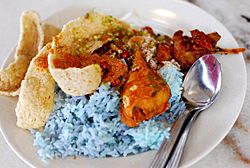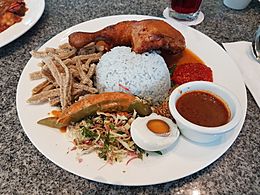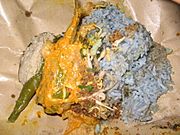Nasi kerabu facts for kids

Nasi kerabu served with various herbs, solok lada (fish meat-stuffed chili pepper), salted egg, fried fish, keropok and marinated chicken
|
|
| Course | Main course, usually for breakfast |
|---|---|
| Place of origin | Malaysia |
| Region or state | Kelantan |
| Serving temperature | Room temperature |
| Main ingredients | Rice cooked with Clitoria ternatea (butterfly-pea) flowers or turmeric, various herbs, coconut (sambal nyor), budu |
Nasi kerabu is a super colorful and tasty Malaysian rice dish. It's famous for its bright blue rice! This special rice is often served with yummy fried chicken or fish, crunchy crackers, and fresh salads.
The amazing blue color comes from the petals of a flower called Clitoria ternatea, also known as the butterfly-pea flower (or bunga telang). These flowers are a natural way to color the rice. Sometimes, the rice can also be plain white or yellow from turmeric. People often enjoy Nasi kerabu with solok lada (which are peppers stuffed with fish) and crispy fried keropok (crackers).
This dish is very popular in the eastern parts of Peninsular Malaysia, especially in places like Kelantan and Terengganu. You can find it all over Malaysia now, and even in southern Thailand, where it's called khao yam (Thai: ข้าaยำ).
Contents
Where Does Nasi Kerabu Come From?
Rice has been a super important food for people in Malacca and the Malay Archipelago for a very long time. It's a key part of many local meals. Usually, rice is cooked in water, coconut milk, or both, and then served with other tasty bits. In Malaysia, rice is often the main part of the meal, not just a side dish. The extra foods served with it are like the "side dishes."
That's why many Malaysian dishes have "nasi" in their name, which means "cooked rice" in Malay. The rest of the name tells you something special about the rice or what it's served with. Nasi kerabu literally means "rice with salad." Kerabu is a traditional Malaysian salad made from vegetables and herbs.
How Nasi Kerabu is Special
Nasi kerabu is similar to other Malaysian dishes, like nasi ulam, where rice is served with vegetable salad and other foods. But what makes Nasi kerabu truly special is its bright blue color! This color comes from the natural food coloring of the butterfly-pea flowers, which grow naturally in Southeast Asia.
Nasi kerabu first became popular on the northeastern coast of West Malaysia, especially in Kelantan and Terrenganu. From there, it spread to other parts of Malaysia and even to nearby Singapore by the early 2000s. It's also a big hit in the southern parts of southern Thailand, where many Malay people live.
For many people in southern Thailand, Nasi kerabu is more than just a meal. It's a symbol of their culture and their connection to Malaysia. In Thai, this dish is known as khao-yam (Thai: ข้าวยำ).
Making Nasi Kerabu: Ingredients and Types
Nasi kerabu has a few main parts: the cooked rice, a vegetable salad, and usually one or more extra toppings. The blue rice is always there, but the salad and other toppings can change a lot. This means there are many different kinds of Nasi kerabu!
The Blue Rice
To make the blue rice, butterfly-pea flowers (fresh or dried) are soaked in the water used to boil the rice. This makes the water turn a deep blue color. Cooks also add special spices to the water. These often include chopped lemon grass, Kaffir lime leaves, pandan leaves, and sometimes ginger and palm sugar. Sometimes, a little coconut milk is added too.
The Kerabu Salad
The kerabu salad is usually a mix of three or four ingredients. These can be raw, soaked, or sometimes lightly cooked. Common ingredients for the salad include cucumbers, lettuce, cowpea, green beans, water spinach, bok choy, onions, cabbage, paprika, chili peppers, and even bamboo sprouts. The amount of salad is usually about half the size of the rice serving.
Other Tasty Toppings
Besides the vegetable salad, Nasi kerabu almost always includes some kind of animal product. This could be chicken, fish, seafood, or meat. These are often fried or stewed with different sauces.
Two other special Malaysian foods often served with Nasi kerabu are solok lada and telur masin.
- Solok lada are peppers that are fried and stuffed with grated young coconut flesh.
- Telur masin is a duck (or sometimes chicken) egg that has been soaked in salty water with spices. Usually, one or two stuffed peppers and half a salted egg are served with each plate of Nasi kerabu. The egg often has a slightly jelly-like texture and is sometimes served right in its shell.
Finally, the rice and other parts of the dish are often sprinkled with crunchy keropok (crackers).
How to Enjoy Nasi Kerabu
All the different parts of Nasi kerabu are placed on one flat plate. The pile of rice is usually in the middle, but it can also be on the side. The salad and other toppings are placed next to the rice, or sometimes right on top of it.
Like many traditional Malaysian dishes, Nasi kerabu is often served with sambal, a spicy sauce. Sometimes, for special meals or in restaurants, the dish might even be decorated with fresh butterfly-pea flowers!
Nasi kerabu is a main dish that is usually served warm, or sometimes at room temperature. In West Malaysia, it's very popular both in homes and from street food stalls. You can find it in modern restaurants and in traditional eateries. For a quick meal, you can buy a "portable" version at markets or from street vendors. This is a small serving of blue rice with a simple topping, wrapped in paper or newspaper, perfect for eating on the go!
See also





